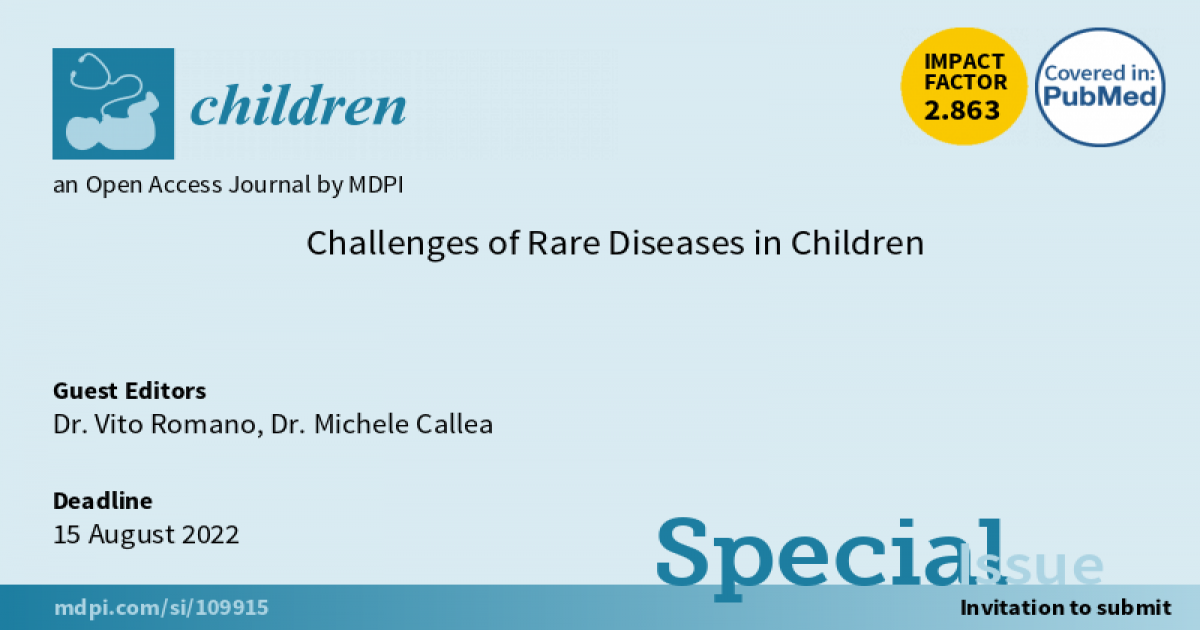Challenges of Rare Diseases in Children
A special issue of Children (ISSN 2227-9067). This special issue belongs to the section "Global Pediatric Health".
Deadline for manuscript submissions: closed (15 August 2022) | Viewed by 36906

Special Issue Editors
2. Department of Eye and Vision Science, Institute of Life Course and Medical Sciences, University of Liverpool, Liverpool, UK
Interests: cornea; ocular surface; corneal transplantation; endothelial keratoplasty; anterior lamellar keratoplasty; keratoconus; imaging; innovative technique; corneal neovascolarization
Interests: dentistry; oral health; oral hygiene; oral medicine; oral biology; dental care; pediatric dermatology; ectodermal dysplasia; hypodontia; hyperdontia; oral manifestations in rare diseases; cleidocranial dysplasia; amelogenesis imperfecta; dentinogenesis imperfecta; x linked reticulated pigmentary disorder; turner syndrome; williams-beuren syndrome; alagille syndrome; neurofibromatosis; cornelia de lange syndrome; allgrove syndrome; developmental biology
Special Issues, Collections and Topics in MDPI journals
Special Issue Information
Dear Colleagues,
Rare diseases are a complex of over 5000 pathologies that represent 10% of the entire human pathology. In 2001, the European Commission decided to consider those pathologies whose incidence does not exceed 5 cases per 10,000 inhabitants as rare. A total of 80% of rare diseases are of genetic origin. Rare diseases have in common:
a) Chronic and disabling features that have social implications;
b) Challenges in diagnosis;
c) Difficulty in treating: often, there are no effective therapies and no targeted drugs are available (due to the limited market, there is little interest in developing the research and production of so-called orphan drugs);
d) A limited number of specialized centers for diagnosis and treatment;
e) Difficulties in identification and access to patients;
f) Fragmentation of patients between centers, which is an obstacle to controlled clinical trials and consequently to therapeutic innovations.
As 80% of rare diseases are of genetic origin, most of them occur in pediatric patients.
We would be delighted if you agreed to be one of the authors of this initiative. Furthermore, we would be happy to accept your suggestion for a title on a topic in which you are an expert.
Aim and scope of the Special Issue:
To create a wider knowledge in rare diseases, a field often neglected, in a multidisciplinary way.
Cutting-edge research:
As 80% of rare diseases are of genetic origin, most of them occur pediatric patients.
The introduction of gene therapy into the clinic is a major game changer in the field of the diagnosis and therapy of rare genetic diseases.
The kind of papers we are soliciting:
Reviews, and original research article related to all aspects of rare diseases.
Dr. Vito Romano
Dr. Michele Callea
Guest Editors
Manuscript Submission Information
Manuscripts should be submitted online at www.mdpi.com by registering and logging in to this website. Once you are registered, click here to go to the submission form. Manuscripts can be submitted until the deadline. All submissions that pass pre-check are peer-reviewed. Accepted papers will be published continuously in the journal (as soon as accepted) and will be listed together on the special issue website. Research articles, review articles as well as short communications are invited. For planned papers, a title and short abstract (about 100 words) can be sent to the Editorial Office for announcement on this website.
Submitted manuscripts should not have been published previously, nor be under consideration for publication elsewhere (except conference proceedings papers). All manuscripts are thoroughly refereed through a single-blind peer-review process. A guide for authors and other relevant information for submission of manuscripts is available on the Instructions for Authors page. Children is an international peer-reviewed open access monthly journal published by MDPI.
Please visit the Instructions for Authors page before submitting a manuscript. The Article Processing Charge (APC) for publication in this open access journal is 2400 CHF (Swiss Francs). Submitted papers should be well formatted and use good English. Authors may use MDPI's English editing service prior to publication or during author revisions.
Keywords
- rare diseases
- multisystemic manifestations
- aniridia
- ocular anterior segment dysgenesis
- ocular posterior segment dysgenesis
- hypodontia
- hyperdontia
- ectoderma
- ocular disorders
- Meibomian glands disease
- skin
- dental defects
- nails
Benefits of Publishing in a Special Issue
- Ease of navigation: Grouping papers by topic helps scholars navigate broad scope journals more efficiently.
- Greater discoverability: Special Issues support the reach and impact of scientific research. Articles in Special Issues are more discoverable and cited more frequently.
- Expansion of research network: Special Issues facilitate connections among authors, fostering scientific collaborations.
- External promotion: Articles in Special Issues are often promoted through the journal's social media, increasing their visibility.
- Reprint: MDPI Books provides the opportunity to republish successful Special Issues in book format, both online and in print.
Further information on MDPI's Special Issue policies can be found here.







